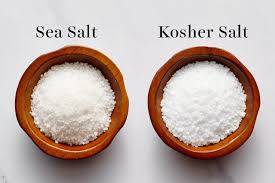The Difference Between Sea Salt and Table Salt
Salt, a fundamental mineral used in cooking and food preservation, comes in many varieties. Two of the most common types are sea salt and table salt. While both serve the same primary function, they differ significantly in their origin, processing methods, mineral content, and uses. Understanding these differences can help consumers make more informed choices for culinary or health reasons.
Origin and Production
The primary distinction between sea salt and table salt lies in their origin. Sea salt is harvested through the evaporation of seawater. The process involves allowing water from the ocean to evaporate under the sun or using mechanical evaporation techniques, leaving behind the salt crystals. The mineral content of sea salt reflects the trace elements found in the sea water, which can vary depending on location.
On the other hand, table salt is typically mined from underground salt deposits. These deposits were formed millions of years ago when ancient seas evaporated, leaving vast layers of salt. After being extracted, table salt is heavily processed to remove impurities and other minerals, resulting in a fine, white, and uniform product.
Processing and Additives
Table salt undergoes more extensive processing compared to sea salt. During the refining process, impurities, minerals, and trace elements present in the raw salt are removed. This gives table salt its fine texture and pure white color. Additionally, anti-caking agents are often added to table salt to prevent clumping, ensuring that it flows freely.
Sea salt, however, is less processed and usually retains more of its natural minerals. While some sea salts are finely ground, many come in larger crystals or flakes. Sea salt may also contain minerals like magnesium, calcium, and potassium, which are typically stripped away from table salt during refining. These trace minerals can give sea salt a slightly different taste and texture, though the differences are subtle.
Some varieties of sea salt, such as Himalayan pink salt or Celtic sea salt, are particularly prized for their mineral content and unique colors, adding an aesthetic appeal to dishes as well as a distinct flavor.
Mineral Content and Flavor
Because of its minimal processing, sea salt often contains a broader range of minerals than table salt. These minerals, although present in small quantities, can contribute to its slightly different flavor profile. The taste of sea salt is often described as more complex, with a slightly briny or earthy flavor that can vary depending on the source of the sea water.
Table salt, being stripped of these minerals, has a more neutral and pure salty taste. For most people, this is the familiar flavor associated with salt. However, because of its finer texture, table salt can dissolve more quickly, making it ideal for certain recipes where precision in seasoning is necessary.
Health Considerations
From a health perspective, both sea salt and table salt contain similar amounts of sodium by weight, and consuming either in excessive amounts can lead to the same health risks, such as high blood pressure. However, some people believe that sea salt, due to its trace minerals, may be a healthier option, though these minerals are present in such small quantities that their health benefits are minimal.
One area where sea salt can differ is in its moisture content. Because sea salt retains more water, it can sometimes have a slightly lower sodium concentration by volume compared to table salt. This means that if you measure by volume (e.g., teaspoons), sea salt may provide a little less sodium than an equal volume of table salt, though the difference is usually minor.
Conclusion
In summary, while both sea salt and table salt are fundamentally the same product, their differences lie in the way they are produced, their mineral content, and their texture. Sea salt retains more of its natural minerals and is less processed, offering a different texture and flavor profile compared to the fine, uniform, and heavily processed table salt. For most culinary uses, either type of salt can work, but choosing one over the other often comes down to personal preference, taste, and health considerations.


